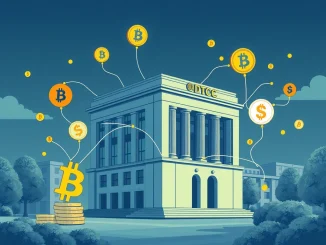
Get ready for a significant step forward in the world of digital assets! Gibraltar, known for its forward-thinking approach to finance, has just announced plans to launch the world’s first regulatory framework specifically designed for the clearing and settlement of crypto derivatives. This move is set to bring a new level of structure and security to this complex corner of the market.
Understanding the Gibraltar Crypto Clearing Framework
So, what exactly is this new framework all about? At its core, the Gibraltar crypto clearing framework aims to adapt established financial market principles to the unique characteristics of virtual assets. Developed through a collaboration between the Government of Gibraltar, the Gibraltar Financial Services Commission (GFSC), and the crypto exchange Bullish, these new rules are designed with a clear purpose: to enhance market integrity.
Here’s a quick breakdown of the key goals:
- Reducing Counterparty Risk: In traditional finance, clearing houses step in to guarantee transactions, ensuring that if one party defaults, the trade still settles. This framework brings that crucial function to crypto derivatives.
- Enabling Recognized Clearing Houses: The rules will allow approved clearing houses to handle virtual asset derivative contracts, providing a layer of oversight and stability.
- Enhancing Transparency and Reliability: By adapting traditional clearing standards, the framework seeks to make the crypto derivatives market more predictable and trustworthy.
Why is Digital Asset Regulation Crucial for Derivatives?
Derivatives, whether traditional or crypto, inherently carry risk. They are contracts whose value is derived from an underlying asset (like Bitcoin or Ethereum). While they offer powerful tools for hedging or speculation, they also involve significant counterparty risk – the risk that the other party in the contract won’t fulfill their obligation.
This is where a robust digital asset regulation comes into play. Without a central clearing mechanism, participants are exposed directly to each other’s potential failures. This can create systemic risk, especially in volatile markets. Gibraltar’s initiative directly addresses this by creating a regulated environment for clearing, which acts as a central guarantor for trades.
How Does This Clearing Framework Work in Practice?
The framework is built on the foundation of traditional financial clearing models but tailored for the digital asset space. Think of it like this:
Traditionally, when two parties trade a derivative, they face each other directly. If one side goes bust, the other is left exposed.
With clearing, a central clearing house inserts itself between the two parties. It becomes the buyer to every seller and the seller to every buyer. This process, known as ‘novation’, means neither original party is directly exposed to the other’s default risk. The risk is mutualized and managed by the clearing house, which typically requires participants to post margin (collateral) to cover potential losses.
Gibraltar’s framework applies this principle to crypto derivatives, providing a much-needed layer of security and reducing the ripple effects of potential defaults within the market.
Collaboration: The Power Behind the Framework
This pioneering effort wasn’t developed in a vacuum. The collaboration between the Government of Gibraltar, the Financial Services Commission (GFSC), and a major industry player like Bullish is key. This partnership ensures that the regulatory framework is not only sound in principle but also practical and implementable for businesses operating in the crypto space.
The GFSC’s expertise in financial regulation, combined with Bullish’s experience in digital asset markets, provides a strong foundation for rules that are both protective of investors and supportive of innovation.
What Does This Mean for Crypto Regulation Globally?
Gibraltar’s move is a significant development in the broader landscape of crypto regulation. By being the first jurisdiction to establish a dedicated framework for clearing crypto derivatives, it sets a precedent. Other jurisdictions grappling with how to oversee these complex products will likely look to Gibraltar’s model.
This could potentially lead to:
- Increased institutional participation in crypto derivatives markets, as regulated clearing provides the certainty and risk management they require.
- Greater clarity and confidence for market participants.
- Pressure on other financial centers to develop similar frameworks.
While this is a positive step, challenges remain. Ensuring interoperability with other potential frameworks, adapting to the rapid pace of innovation in crypto, and achieving consistent global standards are ongoing tasks.
In Conclusion
Gibraltar’s announcement of the world’s first regulatory framework for clearing crypto derivatives is a landmark moment. By focusing on reducing counterparty risk and enabling regulated clearing houses, the jurisdiction is taking a proactive approach to bringing stability and integrity to a vital part of the digital asset market. This move not only strengthens Gibraltar’s position as a forward-thinking financial center but also provides a potential blueprint for how other jurisdictions can safely integrate complex crypto products into the regulated financial system. It’s a powerful step towards maturing the crypto market and unlocking its full potential for a wider range of participants.



